|
SpaceTides
Newsletter #35
- 6 September 2005
Internet
Newsletter of ASSA Bloemfontein Centre,
South Africa, to the public
www.assabfn.co.za/spacetides
|
In this issue of SpaceTides
|
INDEX
1. Spaceflight news from around the world
2. Astronomy news from around the world
3.
Interesting space facts
4.
Space questions
5.
Astronomy in Southern Africa
6.
Astronomy events in the City of Bloemfontein
7. Web links & Net nodes
|
Dear
SpaceTides subscribers
On
Sunday evening (4 September 2005) Carte Blanche (RSA) aired an interesting
story on an ex-South African who made many millions selling software
and then establishing his own rocket company. His aim is to considerably
decrease the launch costs of rockets.
It makes one think - we use more efficient cars and aircraft every
year and more efficient household appliance, etc. But rocket efficiency
pretty much remained the same the past few decades. In some people's
eyes that is simply just not acceptable! (I know I don't like it).
Fortunately there are people out there with the money and sense
to do something about the situation. You can visit the company's
website at: http://www.spacex.com/
And, SALT's first colour images have been placed on their website!
See article below, section 2...
Gerrit Penning
Editor
Total subscribers as at 5 September 2005: 316 (+51
from previous issue, no. 34)
|
|
1. Spaceflight news from around the world
|
|
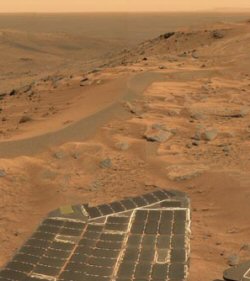
Only a
part of the larger panoramic image taken by Spirit is shown here.
Image Credit: NASA/JPL. Go
to FULL RESOLUTION image.
|
View from the Top: Spirit on Martian Hill
From
JPL News release:
September 1, 2005
Stunning
photos were recently taken by the Martian Rover Spirit and
placed on the JPL website after the robotic car reached the summit
of Husband Hill. The views are unbelievable and reminiscent
of eerie scenes from a Sci-Fi movie. Do yourself a favour and visit
the page with the high resolution images (link below picture at
left).
Spirit is currently 106 meters higher than its original landing
site. Both Spirit and its twin, Opportunity on the other side of
the planet, finished their primary missions in April 2004, but due
to their excellent operational abilities continued to do research
on the planet.
Scientists said that they are finding "abundant evidence
for alteration of rocks in a water environment" from the
research performed so far. Climbing to higher vantage points provides
them with a better understanding of what they're working with and
helps them to plan new routes for the Rover(s).
Article link: http://www.jpl.nasa.gov/news/news.cfm?release=2005-141
|
|
2. Astronomy news from around the world
|
|
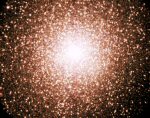
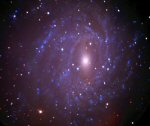
Image
credits: SALT
|
'First Light'
for SALT!
SALT
news release - www.salt.ac.za
The South
African Large Telescope (SALT) has acquired its first colour image
of objects in space, through its $600 000 SALTICAM digital camera.
As indicated on the SALT website: "SALT is the largest
optical telescope in the southern hemisphere, and equal to the largest
in the world... SALT can detect objects as faint as a candle
flame on the moon."
The website also states that the sharpness of SALT's images will
improve as the camera is fine-tuned, but images of only 1 arcsecond
can already be obtained.
SpaceTides wishes to congratulate SAAO and the SALT team
on this major milestone and we hope for an endless supply of cosmic
photons for the future!
Full resolution images and more: http://www.salt.ac.za/content/first_light/
|
|
3. Interesting Space Facts
|
|
-
The Moon used to be much closer to Earth than
it is today. About a billion years ago it took the moon only 20 days
to make an orbit around the Sun (today it takes about 29 days). The interaction between the Earth
and the moon also results in the Earth slowing 2 milliseconds per
century.
900
million years ago, a day was only 18 hours long on Earth! So, if you live for another few 100 million years, you might
finally get all the to-do list things done during your one-Earth
day!
http://seds.lpl.arizona.edu/nineplanets/nineplanets/earth.html
- One of Jupiter's four largest moons
is called Europa. Its surface resembles images of sea ice
on Earth. Scientists speculate that Europa might hold a large "ocean"
of liquid substance (e.g. water) underneath its icy crust. In the
future, spacecraft with the necessary equipment will hopefully be
able to land on Europa and drill down towards this possible ocean.
http://seds.lpl.arizona.edu/nineplanets/nineplanets/europa.html
- It would take you 100 000 years to travel from the one
end of our spiral Milky Galaxy to the other end, if you travel at
the speed of light (300 000 km/s).
- The Hubble Space Telescope needs
to be very steaddy accurate to take photos. "The telescope
is able to lock onto a target without deviating more than 7/1000th
of an arcsecond, or about the width of a human hair seen at a distance
of 1.6 kilometers". http://hubblesite.org/reference_desk/facts_.and._figures/
|
|
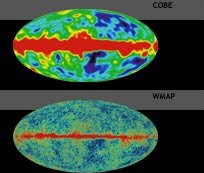
COBE,
WMAP images of the Universe's CMB. (The red line is microwave radiation
from our own galaxy)
|
What is the "Cosmic Microwave Background Radiation"?
The
CMB radiation is energy filling the universe that is believed to
be the radiation remaining from the Big Bang. It is also sometimes
referred to as the "primal glow." Its microwave frequency
of the spectrum shows strongest. The radiation's intensity is almost
exactly the same from every part of the sky. The existence of the CMB radiation was first predicted
by George Gamow in 1948, and by Ralph Alpher and Robert Herman in
1950. It was first observed inadvertently in 1965 by Arno Penzias
and Robert Wilson at the Bell Telephone Laboratories at Murray Hill,
New Jersey.
http://hubblesite.org/reference_desk/glossary/cosmology.shtml
http://map.gsfc.nasa.gov/m_uni/uni_101bbtest3.html
|
_________________________________________________________________________________________________________________________
|

Artist
impression of a black hole - from BBC Sci-Tech's "The home-made
black hole"
|
How
do astronomers know black holes exist if even light cannot escape
from them?
Although
black holes (the remains of extremely large collapsed stars) cannot
be seen directly, their gravitational effect on nearby objects like
other stars can be observed. One such instance is when black
holes "eat" stars orbiting them - sucking in their gas.
X-rays are emitted in the process due to the gas experiencing friction
as it swirls into the black hole at immense speeds. The X-rays can
be observed by Earth's radio telescopes. Also: a binary star's
total mass can be calculated and if the mass is much more than the
visible star's mass, the presumption can be made that its
companion is a black hole.
More info
at: http://www.bbc.co.uk/science/space/deepspace/blackholes/
|
|
5. Astronomy in Southern Africa
|
|
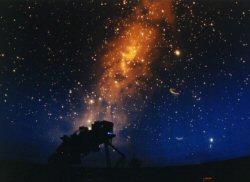 Credit:
Johannesburg Planetarium Credit:
Johannesburg Planetarium
|
The Johannesburg
Planetarium
The
history of the Johannesburg Planetarium, situated on the campus
of the University of the Witwatersrand, dates back to 1956 and had
its origins during the 70th anniversary of the city's founding.
Operations began in 1960. Currently, the only other major planetarium
in SA is in Cape Town.
Visiting the Planetarium is an exciting event and visitors are awed
by the images of the night sky projected onto the planetarium's
dome. Remember to attend a show next time you are in the vicinity.
For complete information regarding show times, directions, contact
details, etc., go to the website at http://www.wits.ac.za/planetarium/
|
For
other SA Astronomy websites, go to the SpaceTides SA Astronomy
Portal at:
www.assabfn.co.za/spacetides/sa_astronomy.htm
|
6. Astronomy Events in the City of Bloemfontein
|
The different
astronomy organisations in the City, working hand-in-hand to inform
people about the interesting
world of astronomy and spaceflight,
can be reached at the following contact details:
|
|
Boyden Observatory Science Centre:
www.assabfn.co.za/friendsofboyden/explore.htm
One
of the most publicly accessible observatories of its kind in the
Southern Hemisphere, also housing SA's third largest telescope.
To arrange group visits to the Observatory, phone Dr. Matie Hoffman
at 051-401 2924 for more information, or send an e-mail to him at:
HoffmaMJ.SCI@mail.uovs.ac.za
Next
Boyden Open Evening/Volgende Boyden Ope-aand: Saturday 10 September 2005, 18h30 for 19h00. Experts will
talk about Earth's natural satellite, the Moon. R30 per vehicle,
snacks will be sold. Observations through telescope if weather permits.
|
|
|
The Friends of Boyden: www.assabfn.co.za/friendsofboyden
A public interest group for Boyden Observatory and for people
interested in joining the astronomical community of Bloemfontein,
but not make astronomy their "full-time" hobby.
Contact Braam van Zyl at 051-436 7555 (h) or visit the website above
for more information regarding the Friends. Anyone can become a
member. R50 membership fee per year for a whole family. Members
receive the latest information on astronomy events in Bloem, attend
the Friends' presentations free of charge and receive the "Naghemel"
quarterly newsletter compiled by ASSA Bloemfontein by post.
|
|
|
ASSA
Bloemfontein
Centre: www.assabfn.co.za
Affiliated with the Astronomical Society of Southern Africa, the
Bloemfontein Centre of ASSA is an active organization of amateur
astronomers meeting on a regular basis to discuss and practise astronomy
as hobby. Activities include solar-, lunar-, deep sky- and comet
& meteor observations, as well as historical research, telescope
building, tours and away-weekends under dark skies. Send an e-mail
to mail@assabfn.co.za or
visit the website. Interested persons can also contact Phillip Coetzer:
084 627 7626.
|
Onthou ook om Boyden Sterrewag se gereelde sterrekunde berigte in die
"Ons Stad" plaaslike koerant te lees.
Dit bevat ook meer inligting rakende Boyden besoektye.
SpaceTides is a free internet e-zine for persons interested in expanding their
general knowledge of astronomy and spaceflight.
The e-zine originates from the City of Bloemfontein in South Africa and
is compiled us a service to the public by ASSA Bloemfontein Centre
as part of their educational outreach activities. Website: www.assabfn.co.za.
SpaceTides contains links to various other third party sites on the
internet, not always connected to SpaceTides. The persons and entities
responsible
for compiling SpaceTides will not be held responsible for the content
or information on these third party sites or any damage of any kind
incurred from
downloading, opening, or viewing anything from/through these sites.
If you would like to unsubscribe from SpaceTides, send an e-mail
to spacetides@assabfn.co.za with the word
"Unsubscribe" in the subject line.
|



